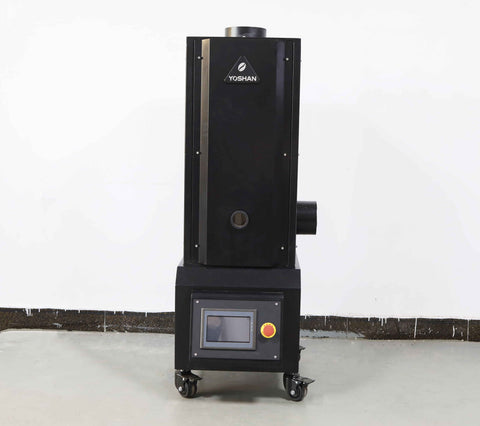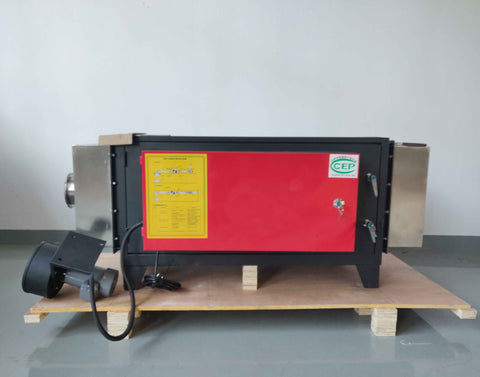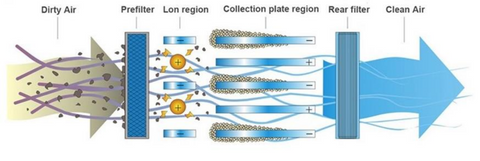Do I Need A Filtration Device For My Coffee Roaster?
Smoke and odours are natural by-products of roasting coffee beans. Filtration devices can reduce smoke by up to 90% depending on various circumstances.
There are two major parts of smoke removal: visible and odorous. Visible smoke can be seen from afar. Odour on the other hand is coffee flavoured scent. Both visible smoke and odour need to be treated, but some methods are better than others at treating one or the other.
There are currently 3 ways to reduce smoke during the roasting process – with an Afterburner, an ESP Smoke filter or a Wet Scrubber.
1. What is an Afterburner?

The more traditional way of minimising smoke in a coffee roastery is with an afterburner. An afterburner is essentially an insulated tube with a high power gas burner. Smoke enters the chamber and is incinerated by the burner into carbon. Nearly all of the volatile organic compounds (VOCs), toxic materials and smoke particles are reduced to carbon, leaving virtually no visible smoke or odour.
Why an afterburner?
—Catalytic Afterburner
A catalytic afterburner is the modern upgrade to an afterburner, adding catalytic converter to the burner. One of the main advantages of a catalytic afterburner is that they reduce the operating temperature of the afterburner. Afterburners require about 700 to 800°C to reduce smoke to carbon. By using a catalytic converter, you can reduce the temperature to about 350 or 400°C, which means that you also use far less gas.
—Reticulating Afterburner
These unique devices reuse the hot air from the afterburner for roasting. After the smoke and odour are burned off, the hot air is fed back into the roaster to roast the beans. This is by far the most energy-efficient smoke abatement system on the market.
—Efficacy and Sustainability
Afterburners can reduce 90-95% of the visible smoke and odour from your roastery.
We cannot get away from the sustainability issue, but we can at least reduce the impact that smoke has on our immediate community by filtering out the smoke that our coffee roasters produce. Just remember that a coffee roasting machine in itself does not produce smoke. It is the coffee that you put into the roaster that produces smoke.
However the initial capital investment for an afterburner is not cheap and if you add a catalytic converter to that it is even higher (but a cat almost halves your gas bill). By increasing your initial investment, you can decrease your running cost on the afterburner by using a catalytic converter. Therefore for long term, it's worthy the investment on it.
2. What is an Electrostatic Precipitator (ESP)?

The second way of reducing smoke is through an electrostatic precipitator (ESP). An ESP works by producing an extremely high voltage current that passes on the electrons to the smoke, charging the smoke negatively and allowing magnetism to do its magic in filtering out the ions.
From the view of the schematic diagram, the dirty smoke air may together with the coffee chaff, through the filter system and finally get the clean air out of the pipe. Only leaves parts of coffee aroma smell in your coffee shop or your roastery.

Why ESP Smoke Filter?
—Environmental friendly: using electricity, so they generate no direct greenhouse gases.
—High smoke removal efficiency: can remove approximately 95% of smoke particles.
—Easy to clean and maintain: there are simple controls with basic venting and electrical components.
—Durability: these products possess a long lifespan.
—Low cost: only 1/4 cost of an afterburner.
However compared with an afterburner, ESP smoke filter requires more often maintenance to keep it clean. The plate after period of time using will have all the smoke particles attached to it. Therefore needs to be washed and can bem time-consuming and labour intensive. Your maintenance schedule will depend on your roasting load and frequency. A pressure washer is ideal for this.
ESP devices are not nearly as effective as afterburners on larger coffee roasters. While a 6kg machine may still get away with 2x ESPs in series, a 15kg will need 4x ESPs in a 2x2 grid configuration to be as effective as an afterburner. Even 4x ESPs will still be cheaper than a single afterburner, but the time that it will take to clean out the ESPs with a pressure washer may well be worth the additional investment.
3. What is a Wet Scrubber? (we don't supply this type)
The third way of reducing smoke is with a wet scrubber. When the hot air from the coffee roaster enters the wet scrubber filtration system, it flows through a chamber containing atomized water that flash-evaporates on contact, cooling the contaminants to a temperature low enough that they condense from vapour into droplets. The centrifugal force inside the cyclone then draws the droplets to the walls where they are caught by a flow of water and flushed downward.
The wet scrubber’s main claim to fame is the handling of gaseous emissions, which are assumed to be the primary culprit of odour transmission. They also reduce the risk of fires by maintaining a clean cyclone and stack.
A well-known roasters’ forum describes wet scrubbing as follows: “It is basically a device that takes air pollution and turns it into water pollution”. By only trapping the pollutants in the water, you run the risk of contaminating the wastewater system with corrosive and harmful partials, which requires further treatment to meet wastewater regulations.

VortX has had the wastewater from the EcoFilter tested by a laboratory certified by EPA. The water can be safely put into any gray water system. Better yet, water your garden: the nutrient rich water promotes growth.